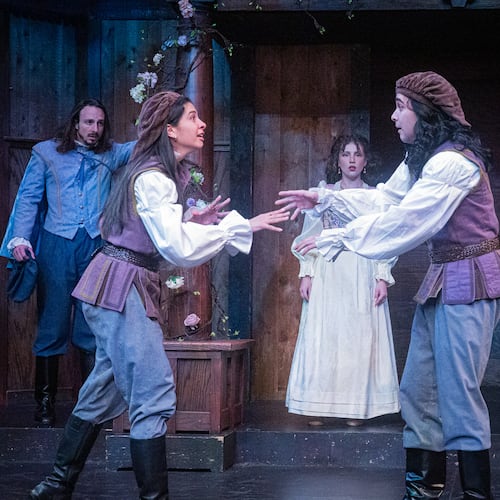Despite being perpetually paved over with new construction, Atlanta has a colorful pop culture past that brought together music, sports and Hollywood.
Whether it was the Sex Pistols launching their U.S. tour at the Great Southeast Music Hall in 1978, rasslin’ and roller derby at the Municipal Auditorium, George Burns performing stand-up at the Playboy Club or disco dancers doing the hustle at Burt Reynolds’ nightspot, Burt’s Place, the stories run deep.
This story originally appeared in the March/April 2016 edition of Living Intown Magazine.
Here’s a retrospective of five hotbeds of creativity and spectacle — some still standing, some not — that helped ignite the embers of Atlanta’s culture.
1. The World of Sid & Marty Krofft
Credit: AJC file
Credit: AJC file
CNN Center’s 205-foot escalator didn’t always whisk guests on a tour of the cable media giant. On May 26, 1976, it began shuttling visitors to the World of Sid & Marty Krofft, a surreal indoor theme park light years ahead of its time. The Krofft brothers, producers of trippy Saturday morning TV kiddie fare (“H.R. Pufnstuf,” “Land of the Lost”), poised themselves to be psychedelic versions of Walt Disney. Presiding over their own vertically stacked park, the Kroffts invited guests to experience this family-friendly venue for flights of fancy. Attractions included a mind-bending take on a circus sideshow, a ride inside the inner workings of a giant pinball machine, Pufnstuf’s Living Island Adventure ride, and a Crystal Carousel inhabited by mystical creatures. However, due to dwindling attendance, technical issues and other problems, the $14 million creation shut its doors in less than six months.
Memorable moment: A who's-who of 1970s stars gathered at the gala opening, including Tony Orlando, Ernest Borgnine, and Donny and Marie Osmond. The Atlanta Symphony Orchestra backed Kate Smith as she sang "God Bless America."
2. The Royal Peacock
Although currently a dance club, the original Peacock showed off its plumes as the prime location for Atlanta’s rhythm and blues scene. It originally opened in 1937 as the Top Hat, showcasing top black acts of the day such as Louis Armstrong and Cab Calloway. In 1949, it transformed into the Royal Peacock, becoming Atlanta’s answer to Harlem’s Apollo Theater. Howlin’ Wolf, Ray Charles, Sam Cooke, Etta James, Otis Redding, the Supremes, and Ike and Tina Turner made up just a small sampling of acts that graced the intimate stage. When the Sweet Auburn district went into economic decline during the 1970s, the Peacock’s original luster faded with it.
Memorable moment: On Feb. 24, 1964, the night before he knocked out Sonny Liston in Miami for the World Heavyweight Title, Muhammad Ali celebrated a day early at a Peacock performance by an Atlanta bluesman, the late Julius "Lotsa Poppa" High.
3. Ponce de Leon Park
Credit: Special (Postcard)
Credit: Special (Postcard)
Long before stores and restaurants lined Midtown Place shopping center, the area’s atmosphere hung with the smell of peanuts and Cracker Jacks, as well as the roar of crowds seeing home runs and line drives. Locals lovingly referred to the baseball field at Ponce de Leon Park as “Poncey,” which provided the home to the Atlanta Crackers minor league team and the Atlanta Black Crackers of the Negro American League. The ballpark opened its doors in 1907 and operated until the Crackers moved to Atlanta Stadium in 1965. A looming magnolia in deep center field, just outside of the playing area, still stands along the BeltLine.
Memorable moment: On April 8, 1949, the Atlanta Crackers faced off against the Brooklyn Dodgers. During this three-game exhibition series, Dodgers player Jackie Robinson, the major league’s first black athlete, would take the field, breaking the color barrier.
4. Loew’s Grand Theater
Credit: Charles R. Pugh Jr./AJC
Credit: Charles R. Pugh Jr./AJC
Originally opened in the late 1800s as DeGive’s Grand Opera House, this lavish venue saw a second life as a movie palace beginning in the 1920s. Form the corner of Peachtree and Forsyth streets, the Loew’s Grand served as the first local screening spot for iconic films, including “Singin’ in the Rain,” “Ben-Hur” and “Doctor Zhivago.” By the early 1970s, it began segueing into a hotspot for exploitation cinema along the lines of “Blacula,” “Enter the Dragon” and “Shaft.” Damaged by fire in 1978, the theater was demolished, and today the Georgia-Pacific Tower occupies its former real estate.
Memorable moment: On Dec. 15, 1939, a reported crowd of approximately 300,000 gathered outside of the Loew’s Grand for the Atlanta premiere of “Gone With the Wind.” Although stars, including Clark Gable and Vivian Leigh, were in attendance, its black performers were notably absent due to segregation. Gable reportedly threatened to skip the event but was encouraged to go by black co-star Hattie McDaniel, who won the Academy Award for Best Supporting Actress for the film.
5. Alex Cooley’s Electric Ballroom
The Georgian Terrace Hotel hosted the post-premiere gala of “Gone With the Wind” in 1939, as well as lauded guests such as President Calvin Coolidge and F. Scott Fitzgerald. In 1974, however, late concert promoter Alex Cooley turned up the volume by opening Alex Cooley’s Electric Ballroom in the hotel’s Grand Ballroom. Rockers who would go on to pack arenas — think Billy Joel, Kiss, Electric Light Orchestra, Steely Dan, Fleetwood Mac and others — took the stage. The venue unplugged in 1979 and became the Agora Ballroom, which closed in 1983.
Memorable moment: Cooley often shared a story that during a Bruce Springsteen performance, the Boss asked Cooley if he could turn off the cash registers, because they were making too much noise.
Credit: AJC
Credit: AJC
About the Author
Keep Reading
The Latest
Featured



